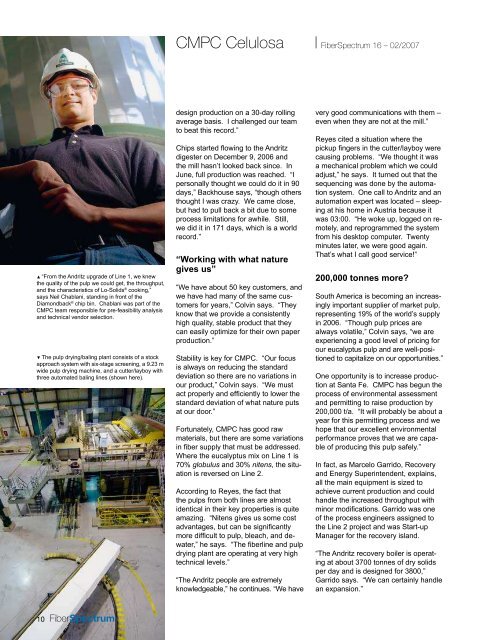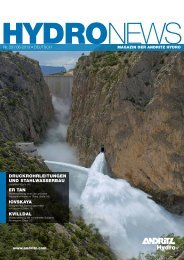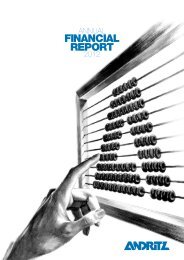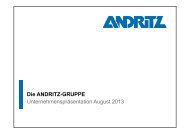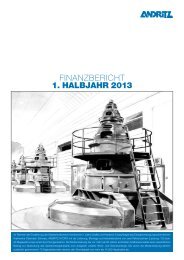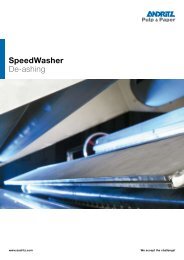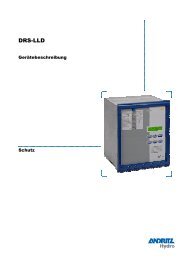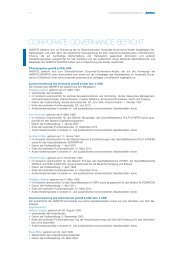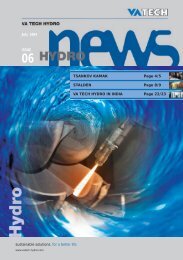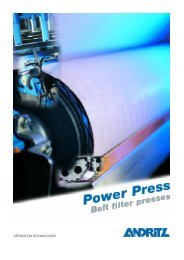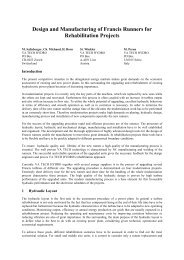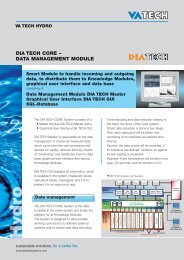FiberSpectrum - ANDRITZ Vertical volute pumps
FiberSpectrum - ANDRITZ Vertical volute pumps
FiberSpectrum - ANDRITZ Vertical volute pumps
Create successful ePaper yourself
Turn your PDF publications into a flip-book with our unique Google optimized e-Paper software.
▲ “From the Andritz upgrade of Line 1, we knew<br />
the quality of the pulp we could get, the throughput,<br />
and the characteristics of Lo-Solids ® cooking,”<br />
says Neil Chablani, standing in front of the<br />
Diamondback ® chip bin. Chablani was part of the<br />
CMPC team responsible for pre-feasibility analysis<br />
and technical vendor selection.<br />
▼ The pulp drying/baling plant consists of a stock<br />
approach system with six-stage screening, a 9.23 m<br />
wide pulp drying machine, and a cutter/layboy with<br />
three automated baling lines (shown here).<br />
CMPC Celulosa | <strong>FiberSpectrum</strong> 16 – 02/2007<br />
design production on a 30-day rolling<br />
average basis. I challenged our team<br />
to beat this record.”<br />
Chips started flowing to the Andritz<br />
digester on December 9, 2006 and<br />
the mill hasn’t looked back since. In<br />
June, full production was reached. “I<br />
personally thought we could do it in 90<br />
days,” Backhouse says, “though others<br />
thought I was crazy. We came close,<br />
but had to pull back a bit due to some<br />
process limitations for awhile. Still,<br />
we did it in 171 days, which is a world<br />
record.”<br />
“Working with what nature<br />
gives us”<br />
“We have about 50 key customers, and<br />
we have had many of the same customers<br />
for years,” Colvin says. “They<br />
know that we provide a consistently<br />
high quality, stable product that they<br />
can easily optimize for their own paper<br />
production.”<br />
Stability is key for CMPC. “Our focus<br />
is always on reducing the standard<br />
deviation so there are no variations in<br />
our product,” Colvin says. “We must<br />
act properly and efficiently to lower the<br />
standard deviation of what nature puts<br />
at our door.”<br />
Fortunately, CMPC has good raw<br />
materials, but there are some variations<br />
in fiber supply that must be addressed.<br />
Where the eucalyptus mix on Line 1 is<br />
70% globulus and 30% nitens, the situation<br />
is reversed on Line 2.<br />
According to Reyes, the fact that<br />
the pulps from both lines are almost<br />
identical in their key properties is quite<br />
amazing. “Nitens gives us some cost<br />
advantages, but can be significantly<br />
more difficult to pulp, bleach, and dewater,”<br />
he says. “The fiberline and pulp<br />
drying plant are operating at very high<br />
technical levels.”<br />
“The Andritz people are extremely<br />
knowledgeable,” he continues. “We have<br />
very good communications with them –<br />
even when they are not at the mill.”<br />
Reyes cited a situation where the<br />
pickup fingers in the cutter/layboy were<br />
causing problems. “We thought it was<br />
a mechanical problem which we could<br />
adjust,” he says. It turned out that the<br />
sequencing was done by the automation<br />
system. One call to Andritz and an<br />
automation expert was located – sleeping<br />
at his home in Austria because it<br />
was 03:00. “He woke up, logged on remotely,<br />
and reprogrammed the system<br />
from his desktop computer. Twenty<br />
minutes later, we were good again.<br />
That’s what I call good service!”<br />
200,000 tonnes more?<br />
South America is becoming an increasingly<br />
important supplier of market pulp,<br />
representing 19% of the world’s supply<br />
in 2006. “Though pulp prices are<br />
always volatile,” Colvin says, “we are<br />
experiencing a good level of pricing for<br />
our eucalyptus pulp and are well-positioned<br />
to capitalize on our opportunities.”<br />
One opportunity is to increase production<br />
at Santa Fe. CMPC has begun the<br />
process of environmental assessment<br />
and permitting to raise production by<br />
200,000 t/a. “It will probably be about a<br />
year for this permitting process and we<br />
hope that our excellent environmental<br />
performance proves that we are capable<br />
of producing this pulp safely.”<br />
In fact, as Marcelo Garrido, Recovery<br />
and Energy Superintendent, explains,<br />
all the main equipment is sized to<br />
achieve current production and could<br />
handle the increased throughput with<br />
minor modifications. Garrido was one<br />
of the process engineers assigned to<br />
the Line 2 project and was Start-up<br />
Manager for the recovery island.<br />
“The Andritz recovery boiler is operating<br />
at about 3700 tonnes of dry solids<br />
per day and is designed for 3800,”<br />
Garrido says. “We can certainly handle<br />
an expansion.”<br />
▲ “Line 2 is operating at design capacity and delivering pulp that fulfills our export customers’ expectations,<br />
which means the same high quality as Line 1,” says Francis Backhouse, Mill Manager.<br />
Garrido stressed that all the technology<br />
his team selected for the recovery<br />
area is proven. “We were not willing to<br />
experiment,” he says.<br />
“I am very impressed with Andritz’s ability<br />
to handle an EPC project,” he continues.<br />
“All the equipment is performing<br />
exactly as it is supposed to. The boiler<br />
runs great. The X-Filters perform great.<br />
It’s a very safe plant to operate and the<br />
support by Andritz after the start-up has<br />
been excellent.”<br />
Andritz continues to provide technical<br />
advisory services to CMPC and is<br />
developing a longer term maintenance<br />
program with CMPC. Andritz has a<br />
service center in nearby Concepcion to<br />
supply parts and technical support.<br />
“This is what we want to see,” Garrido<br />
says, “a relationship that doesn’t end<br />
with the project.”<br />
Says Production Manager Vargas,<br />
“We must keep on working together to<br />
optimize this mill. This is a permanent<br />
relationship, not a temporary one.”<br />
►► find out more at<br />
www.fiberspectrum.andritz.com<br />
Simulation, control,<br />
optimization<br />
The level of automation in the Santa Fe<br />
mill is quite impressive, and Andritz delivered<br />
two important automation tools.<br />
The IDEAS dynamic process simulator<br />
was used to verify the control loop<br />
integrity and check out the DCS. The<br />
simulator also proved to be a very<br />
effective tool for training operators in<br />
advance of the world-record start-up.<br />
Andritz also delivered its ACE ® (Andritz<br />
Control Expert) fiberline optimization<br />
system. ACE ® is based on Andritz’s<br />
extensive fiberline experience. The<br />
foundation for ACE ® is the BrainWave ®<br />
technology. BrainWave ® stabilizes key<br />
process variables by modeling process<br />
behavior to predict – and control –<br />
where the process will move. Traditional<br />
PID controllers, by comparison,<br />
do not have this ability to proactively<br />
direct the process. The ACE ® supervisory<br />
software optimizes control of the<br />
fiberline and provides a full-scale “autopilot”<br />
for the operators to maximize<br />
profitability.<br />
10 11


